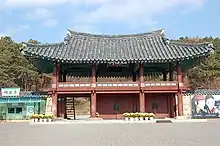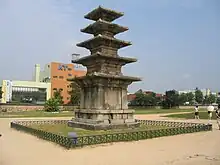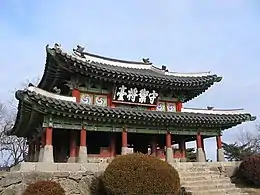Sabi (Korea)
Sabi (Korean: 사비; RR: Sabi) was the third and final capital of the Korean kingdom of Baekje (Korean: 백제; MR: Paekche), from 538 until Baekje’s fall in 660 CE.[1] The site of Sabi is located in modern-day Buyeo County, South Chungcheong Province, in South Korea.
| Sabi | |
| Hangul | |
|---|---|
| Hanja | |
| Revised Romanization | Sabi |
| McCune–Reischauer | Sabi |
Sabi Fortress also is known by the names Busosanseong, Sabiseong or Soburiseong Fortress.[2] It consists of the inner fortress divided by roads centered on the royal palace,[3] a defensive fortress called "Buso Mountain Fortress", and outer walls surrounding the palace. The inner part of the fortress involves 5 district area,[4] where the existence of district was verified through rocks, roof titles, and wooden tablets etched with the name of administrative areas. It is also assumed that the royal palace of Baekje had been located on this site.
Location
The location of Sabi is north of current downtown Buyeo at the southern foot of Busosan Mountain.[5] This location was chosen for its natural fortifications and ease of access to other regions. It was located on a plain on the Geum River,[6] which served as a point of outreach to the southern portion of the Korean peninsula, as well as the Gaya Region. It was located at the foot of mountains, which helped shield it from attacks, though it was surrounded by extensive agricultural lands. The Yellow Sea was nearby as well, which allowed for easy trade with China and Japan.[7]
History
Sabi was the third and final capital of Baekje. The previous capital, Ungjin (KOR: 웅진), was isolated in the mountains, cutting it off from the outside world, making it an unfit location for the capital. King Song, the king of Baekje, moved the capital approximately 30 kilometers southwest to Sabi in 538 CE.[8] Sabi was the capital of the kingdom of Baekje for 120 years until 660 CE, when Baekje fell to an attack from the neighboring kingdom of Silla, combined with forces from Tang Dynasty China.[7] The city officially surrendered on August 24, 660.[9]
During the 120 years, Sabi was under the control of:
- King Song (523-554)
- King Widok (554-598)
- King Hye (598-599)
- King Pop (599-600)
- King Mu (600-641)
- King Uija (641-660)[6]
King Mu attempted to move the capital to Iksan (KOR: 익산) during his reign, but it wasn’t successful.[7]
Sabi Conference(泗沘會議) were held in 541 and 544. See also Anra Conference(安羅會議) in 529
In 541, 1st Sabi Conference be held, Baekje(百濟), Anra(安羅), Daegaya(加羅), Zolma(卒麻), Sanbanhae(散半奚), Dara(多羅), Sagi(斯二岐), Jata(子他), and Anra-wa envoy office(Korean: 안라왜신관, Hanja: 安羅倭臣官) gather. At this meeting, Gaya asked Baekje if they could defend against Silla's attacks. Then, Baekje said Takgitan, Taksun, and Geumgwan Gaya were all ruined by weakness own and promised to defend themselves. In fact, Baekje could not make a strong promise because Baekje needed Silla's help to regain the Han River basin. In July, Anra felt uneasy and contacted Silla through the Anra-wa envoy office(安羅日本府). After noticing this, Baekje(King Seong) called Imna and scolded. Then, emphasizes the history of King Geunchogo's reign[10][11][12] and promise that the three countries that have been destroyed will be restored and returned to the Gaya. In July 542, Beakje declared Gaya Confederacy revival, but this was a just none-action declaration. Anra, who has a resistance, is engaged in diplomacy. In November 543, the Japan declared that it would send out Baekje's generals and castellan within the Imna and Gaya Confederacy through the Anra-wa envoy office(安羅倭臣官). In December 543, King Seong held a Jeongsa Rock Council(Korean: 정사암회의, Hanja: 政事巖會議)[13] to resolve Gaya's rebellion, and the conclusion was to hold 2nd Sabi Conference. Baekje convened a Conference in December 543, but the Gaya Confederacy continued to make excuses, and Baekje, which was angry in February 544, called in the "Anra-wa envoy office" official to insult and send him back to the Japanese state. The Japan announced that it was willing to participate in the Sabi conference, but the Gaya Confederacy did not continue to attend in March. Eventually, in October 544, the envoy of Baekje returned from Japan and promised to grant Gaya the request as much as possible. [14]
In 544 November, 2nd Sabi Conference be held, and eight countries, including Baekje and the Gucha(久嵯國) gather. In order to protect the Gaya Confederacy, King Seong of Baekje said at the meeting, "We will build six castles on the Nakdong River, the border area between Silla and Anra, and instead of stationed 3,000 Japanese soldiers and Baekje troops, Baekje will pay for it." "The reason why Baekje cannot send out its generals and castellan is not to prevent exchanges between Gaya and Japan. In preparation for the attack of Goguryeo and Silla, it is inevitable to send them out.' made an excuse. It also calls for all the Gaya Japanese in the "Anra-wa envoy office(安羅倭臣官)" to be sent to Japan. The Gaya Confederacy disband after saying it think deeply about the proposal. In March and May of 545, Japan and Baekje exchanged envoys. They exchanged again in January, June and July 546. In April 547 Baekje requested Silla, Gaya, and japan to serve as soldiers. In January 548, the Goguryeo-Ye Alliance attacked, but Silla supported 3,000 soldiers and eventually managed to stop them. called Battle of Mt.Doksseong Castle(Korean: 독성산성전투, Hanja: 禿城山城戰鬪)(548). However, after Baekje fought with Goguryeo, they took prisoners and questioned them, and they said, "Anra and wa envoy office(倭臣官) recommended the conquest of Baekje to Goguryeo.' gets information. Baekje sent envoys to Anra three times to confirm the facts, but all of them were rejected. In April 548 Baekje sent envoys to the Japanese government to interrogate them. The Japanese government did not know about it, but Baekje did not believe it and canceled its military request. King Seong led the armies of Silla and Imna as well as the Baekje army, starting the Han River Restoration War(Korean: 한강 수복전, Hanja: 漢江收復戰)(551~553). Through this, Baekje recovers the Han River but is betrayed by Silla in Battle of Gwansan Castle(Korean: 관산성전투, Hanja: 管山城 戰鬪)(554). Then, it ends with Fall of Gaya(562) [15]
Features
The city was surrounded by a two-layered defense. The outer layer was the Busosan Fortress, that guarded the capital from the side that the nearby mountains left open. The inner layer was The Naseong (KOR: 나성) City Wall which encircled the entire capital.[7] The original appearance of both layers are still intact.[16]
The city was divided into 5 administrative districts called bu (KOR: 부), those were divided into 5 smaller districts called hang (KOR: 항).[7]
The royal palace and its surrounding facilities were located directly at the southern foot of Busosan Mountain. There was a man made pond located south of the palace. It was completed in 634, under the orders of King Mu.[17]
Excavation since the 1980s has uncovered the building site of the royal palace, including water supply facilities, storage facilities, a lotus pond. The site of the Jeongnimsa (KOR: 정림사) Temple, which was built in the center of the city, was also discovered, as well as royal tombs just outside the eastern part of the Naseong City Wall.[5] These archeological sites were added to UNESCO World Heritage List in 2015.[18]
Royal Palace
The royal palace and its surrounding facilities are located at the northernmost end of the city. There, a large building site was discovered. The site spans 35m across and 18.5m in length, which is evident from the 50cm tall remains of the platform that once supported the building. Within the site 36 rammed-earth foundations were discovered, which are believed to have supported the pillars and cornerstones of the building.[19]
The site was confirmed to be the royal palace due to three different types of evidence. The first being a gilt-bronze waist belt was found at the site. The belt could have only belonged to a king due to the strict hierarchy of Baekje society at the time. This discovery indicated that the area was once the residence of a king.[20] Roof tiles with inscriptions of the royal court, large stone structures, and a monument to Liu Renyuan of Tang China, were found at the site. These point to the importance of the location, which point to it being the location of the royal palace. The site was also used for local government offices in later Korean dynasties.[21]
Two large, wooden water tanks, five underground, wooden storage facilities, three stone storage facilities, and various other storage pits were also found at the location. A man-made lotus pond that was 10.6m in width, 6.2m in length, and ranged from 1 to 1.2m in depth, was found as well.[22]

Busosan Fortress
The fortress was built to protect the city from the sides that weren’t naturally protected by the surrounding mountains and river. It was built using a rammed-earth technique and had a perimeter of 2,495m, was 5 to 6m wide at the base, and was 3m high. Building sites, including a barracks for Baekje soldiers, as well as Gate Sites have been found within the fortress. Two Gate Sites have been identified, the first, which was the main gate, was on the south side of the fortress, while the second one was on the east side.[22]

Jeongnimsa Temple
The temple was located at the center of Sabi and is still located at the center of modern-day Buyeo. The temple included a central gate, a prayer hall, a lecture hall, and monks’ dormitories that were connected to the main buildings by linking corridors. The layout is believed to either have been “one pagoda and one prayer hall” or “one pagoda and two prayer halls.”[23]
The only thing still remaining of the temple is an 8.3m tall stone pagoda.[24] The pagoda has Chinese characters carved into the surface of it. The writing is celebrating the Tang Dynasty’s victory over the Kingdom of Baekje and was put there by the commanding Tang general, Liu Renyuan.[9]
Royal Tombs

Outside the eastern part of the city wall, 7 tombs are located. The tombs are within mounds of hollowed earth and can be seen as semi-spheres on the hillside. They are arranged in two rows of three mounds, while one mound is located 50m to the north.
The tombs are classified as stone chambers with a corridor and are divided into types based on what type of ceiling they have. The royal tombs of Sabi have three different types present: vault ceiling, hexagonal flat ceiling, and square flat ceiling.[25]
References
- Republic of Korea (2014). "Nomination of Baekje Historic Areas: For Inscription on the World Heritage List Revised Version" (PDF). UNESCO.
- "Busosanseong Fortress in Buyeo". www.buyeo.go.kr. Retrieved 7 September 2012.
- "Gongju and Buyeo Historic Sites (2010)". jikimi.cha.go.kr. Retrieved 7 September 2012.
- "Paekche (ancient kingdom)". /www.britannica.com. Retrieved 7 September 2012.
- "Sabi Period (Buyeo)". Baekje World Heritage Center. 2017.
- Kim, Jinwung (2012). A History of Korea: From Land of the Morning Calm to States in Conflict. Bloomington: Indiana University Press. pp. 40–42. ISBN 978-0253000248. JSTOR j.ctt16gh5vd.
- "History of Baekje". Baekje World Heritage Center. 2017.
- Best, 2006, p. 328.
- Best, 2006, p. 396.
- According to Nihon Shoki: 速古王&貴首王 reign
- Theory 1. meaning Geunchogo of Baekje and Geungusu of Baekje
- Theory 2. meaning Chogo of Baekje and Gusu of Baekje
- Silla also had a unanimous Council named Hwabaek Council
- 日本書紀(Nihon Shoki) 卷第十九 天國排開廣庭天皇 欽明天皇 > 欽明天皇 2年 4月 > 夏四月. 安羅次旱岐夷呑奚·大不孫·久取柔利, 加羅上首位古殿奚, 卒麻旱岐, 散半奚旱岐兒, 多羅下旱岐夷他, 斯二岐旱岐兒, 子他旱岐等, 與任那日本府吉備臣[闕名字.], 往赴百濟, 俱聽詔書. 百濟聖明王謂任那旱岐等言, 日本天皇所詔者, 全以復建任那. 今用何策, 起建任那. 盍各盡忠, 奉展聖懷. 任那旱岐等對曰, 前再三廻, 與新羅議. 而無答報. 所圖之旨, 更告新羅, 尙無所 報. 今宜俱遣使, 往奏天皇. 夫建任那者, 爰在大王之意. 祇承敎旨. 誰敢間言. 然任那境接新羅. 恐致卓淳等禍[等謂㖨己呑·加羅. 言卓淳等國, 有敗亡之禍.]. 聖明王曰, 昔我先祖速古王·貴首王之世, 安羅·加羅·卓淳旱岐等, 初遣使相通, 厚結親好. 以爲子弟, 冀可恆 隆. 而今被誑新羅, 使天皇忿怒, 而任那憤恨, 寡人之過也. 我深懲悔, 而遣下部中佐平麻鹵·城方甲背昧奴等, 赴加羅, 會于任那日本府相盟. 以後, 繫念相續, 圖建任那, 旦夕無忘. 今天皇詔稱, 速建任那. 由是, 欲共爾曹謨計, 樹立任那等國. 宜善圖之. 又於任那境, 徵召新羅, 問聽與不. 乃俱遣使, 奏聞天皇, 恭承示敎. 儻如使人未還之際, 新羅候隙, 侵逼任那, 我當往救. 不足爲憂. 然善守備, 謹警無忘. 別汝所噵, 恐致卓淳等禍, 非新羅自强故, 所能爲也. 其㖨己呑, 居加羅與新羅境際, 而被連年攻敗. 任那無能救援. 由是見亡. 其南加羅, 蕞爾狹小, 不能卒備, 不知所託. 由是見亡. 其卓淳, 上下携貳. 主欲自附, 內應新羅. 由是見亡. 因斯而觀, 三國之敗, 良有以也. 昔新羅請援於高麗, 而攻擊任那與百濟, 尙不剋之. 新羅安獨滅任那乎. 今寡人, 與汝戮力幷心, 翳賴天皇, 任那必起. 因贈物各有差. 忻忻而還.
- 1st Sabi Conference in Emperor Kinmei 2year April (AD 541)
- 日本書紀(Nihon Shoki) 卷第十九 天國排開廣庭天皇 欽明天皇 > 欽明天皇 5年 11月 > 十一月, 百濟遣使, 召日本府臣·任那執事曰, 遣朝天皇, 奈率得文·許勢奈率奇 麻·物部奈率奇 非等, 還自日本. 今日本府臣及任那國執事, 宜來聽勅, 同議任那. 日本吉備臣, 安羅下旱岐大不孫·久取柔利, 加羅上首位古殿奚·卒麻君·斯二岐君·散半奚君兒, 多羅二首位訖乾智, 子他旱岐, 久嗟旱岐, 仍赴百濟. 於是, 百濟王聖明, 略以詔書示曰, 吾遣奈率彌麻佐·奈率己連·奈率用奇 多等, 朝於日本. 詔曰, 早建任那. 又津守連奉勅, 問成任那. 故遣召之. 當復何如, 能建任那. 請各陳謀. 吉備臣·任那旱岐等曰, 夫建任那國, 唯在大王. 欲冀遵王, 俱奏聽勅. 聖明王謂之曰, 任那之國, 與吾百濟, 自古以來, 約爲子弟. 今日本府印岐彌[謂在任那日本臣名也.], 旣討新羅, 更將伐我. 又樂聽新羅虛誕謾語也. 夫遣印岐彌於任那者, 本非侵害其國[未詳.], 往古來今, 新羅無道. 食言違信, 而滅卓淳. 股肱之國, 欲快返悔. 故遣召到, 俱承恩詔, 欲冀, 興繼任那之國, 猶如舊日, 永爲兄弟. 竊聞, 新羅安羅, 兩國之境, 有大江水. 要害之地也. 吾欲據此, 修繕六城. 謹請天皇三千兵士, 每城充以五百, 幷我兵士, 勿使作田, 而逼惱者, 久禮山之五城, 庶自投兵降首. 卓淳之國, 亦復當興. 所請兵士, 吾給衣粮. 欲奏天皇, 其策一也. 猶於南韓, 置郡令·城主者, 豈欲違背天皇, 遮斷貢調之路. 唯庶, 剋濟多難, 殲撲强敵. 凡厥凶黨, 誰不謀附. 北敵强大, 我國微弱. 若不置南韓, 郡領·城主, 修理防護, 不可以禦此强敵. 亦不可以制新羅. 故猶置之, 攻逼新羅, 撫存任那. 若不爾者, 恐見滅亡, 不得朝聘. 欲奏天皇, 其策二也. 又吉備臣·河內直·移那斯·麻都, 猶在任那國者, 天皇雖詔建成任那, 不可得也. 請, 移此四人, 各遣還其本邑. 奏於天皇, 其策三也. 宜與日本臣·任那旱岐等, 俱奉遣使, 同奏天皇, 乞聽恩詔. 於是, 吉備臣·旱岐等曰, 大王所述三策, 亦協愚情而已. 今願, 歸以敬諮日本大臣[謂在任那日本府之大臣也.] 安羅王·加羅王, 俱遣使同奏天皇. 此誠千載一會之期, 可不深思而熟計歟.
- 2nd Sabi Conference in Emperor Kinmei 5year November (AD 544)
- Republic of Korea, 2014, p. 65
- Best, 2006, p. 173.
- "World Heritage List: Baekje Historic Areas". UNESCO. 2015.
- Republic of Korea, 2014, p. 56.
- Republic of Korea, 2014, p. 54
- Republic of Korea, 2014, p. 55.
- Republic of Korea, 2014, p. 58.
- Republic of Korea, 2014, p. 60.
- Republic of Korea, 2014, p. 62.
- Republic of Korea, 2014, 64.
